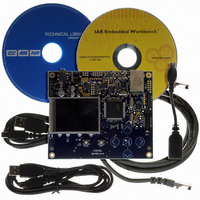ATEVK1105 Atmel, ATEVK1105 Datasheet - Page 133

ATEVK1105
Manufacturer Part Number
ATEVK1105
Description
KIT EVAL FOR AT32UC3A0
Manufacturer
Atmel
Series
AVR®32r
Type
MCUr
Datasheets
1.ATAVRONE-PROBECBL.pdf
(16 pages)
2.ATEVK1104.pdf
(826 pages)
3.ATEVK1105.pdf
(28 pages)
Specifications of ATEVK1105
Contents
Evaluation Board, Software and Documentation
Processor To Be Evaluated
AT32UC3A0512
Processor Series
AVR
Data Bus Width
32 bit
Interface Type
USART, TWI, USB, SPI, Ethernet
Operating Supply Voltage
3.3 V
Silicon Manufacturer
Atmel
Core Architecture
AVR
Core Sub-architecture
AVR UC3
Silicon Core Number
AT32UC3A0512
Silicon Family Name
AVR
Kit Contents
Board CD Docs
Rohs Compliant
Yes
For Use With/related Products
AT32UC3A0
Lead Free Status / RoHS Status
Lead free / RoHS Compliant
- Current page: 133 of 826
- Download datasheet (20Mb)
19.4.1
19.4.2
19.4.3
19.5
19.5.1
32058J–AVR32–04/11
Arbitration
No Default Master
Last Access Master
Fixed Default Master
Arbitration Rules
At the end of the current access, if no other request is pending, the slave is disconnected from
all masters. No Default Master suits low-power mode.
At the end of the current access, if no other request is pending, the slave remains connected to
the last master that performed an access request.
At the end of the current access, if no other request is pending, the slave connects to its fixed
default master. Unlike last access master, the fixed master does not change unless the user
modifies it by a software action (field FIXED_DEFMSTR of the related SCFG).
To change from one kind of default master to another, the Bus Matrix user interface provides the
Slave Configuration Registers, one for each slave, that set a default master for each slave. The
Slave Configuration Register contains two fields: DEFMSTR_TYPE and FIXED_DEFMSTR. The
2-bit DEFMSTR_TYPE field selects the default master type (no default, last access master, fixed
default master), whereas the 4-bit FIXED_DEFMSTR field selects a fixed default master pro-
vided that DEFMSTR_TYPE is set to fixed default master. Please refer to the Bus Matrix user
interface description.
The Bus Matrix provides an arbitration mechanism that reduces latency when conflict cases
occur, i.e. when two or more masters try to access the same slave at the same time. One arbiter
per HSB slave is provided, thus arbitrating each slave differently.
The Bus Matrix provides the user with the possibility of choosing between 2 arbitration types for
each slave:
This choice is made via the field ARBT of the Slave Configuration Registers (SCFG).
Each algorithm may be complemented by selecting a default master configuration for each
slave.
When a re-arbitration must be done, specific conditions apply. See
Rules” on page
Each arbiter has the ability to arbitrate between two or more different master requests. In order
to avoid burst breaking and also to provide the maximum throughput for slave interfaces, arbitra-
tion may only take place during the following cycles:
1. Round-Robin Arbitration (default)
2. Fixed Priority Arbitration
1. Idle Cycles: When a slave is not connected to any master or is connected to a master
2. Single Cycles: When a slave is currently doing a single access.
3. End of Burst Cycles: When the current cycle is the last cycle of a burst transfer. For
which is not currently accessing it.
defined length burst, predicted end of burst matches the size of the transfer but is man-
aged differently for undefined length burst.
133.
See Section “19.5.1.1” on page 134.
Section 19.5.1 ”Arbitration
AT32UC3A
133
Related parts for ATEVK1105
Image
Part Number
Description
Manufacturer
Datasheet
Request
R

Part Number:
Description:
DEV KIT FOR AVR/AVR32
Manufacturer:
Atmel
Datasheet:

Part Number:
Description:
INTERVAL AND WIPE/WASH WIPER CONTROL IC WITH DELAY
Manufacturer:
ATMEL Corporation
Datasheet:

Part Number:
Description:
Low-Voltage Voice-Switched IC for Hands-Free Operation
Manufacturer:
ATMEL Corporation
Datasheet:

Part Number:
Description:
MONOLITHIC INTEGRATED FEATUREPHONE CIRCUIT
Manufacturer:
ATMEL Corporation
Datasheet:

Part Number:
Description:
AM-FM Receiver IC U4255BM-M
Manufacturer:
ATMEL Corporation
Datasheet:

Part Number:
Description:
Monolithic Integrated Feature Phone Circuit
Manufacturer:
ATMEL Corporation
Datasheet:

Part Number:
Description:
Multistandard Video-IF and Quasi Parallel Sound Processing
Manufacturer:
ATMEL Corporation
Datasheet:

Part Number:
Description:
High-performance EE PLD
Manufacturer:
ATMEL Corporation
Datasheet:

Part Number:
Description:
8-bit Flash Microcontroller
Manufacturer:
ATMEL Corporation
Datasheet:

Part Number:
Description:
2-Wire Serial EEPROM
Manufacturer:
ATMEL Corporation
Datasheet:










